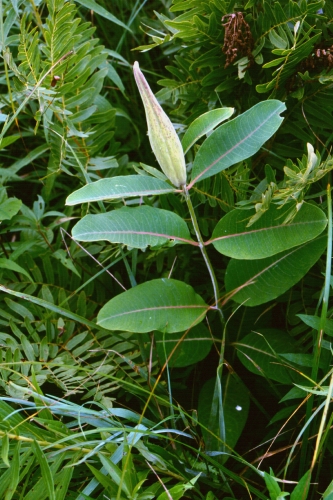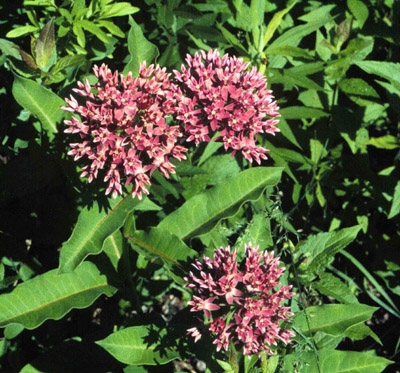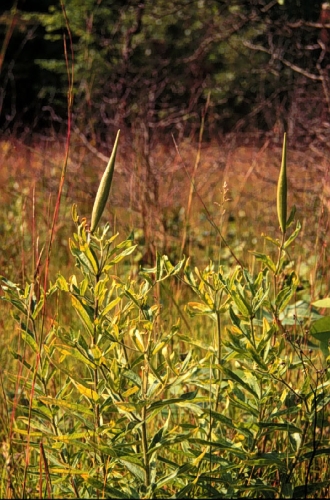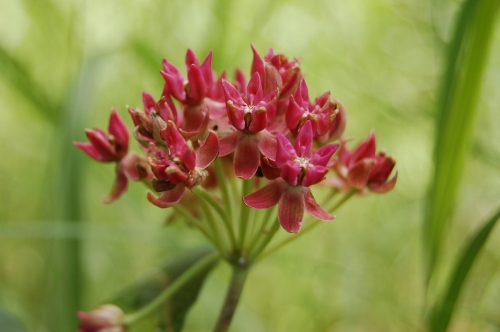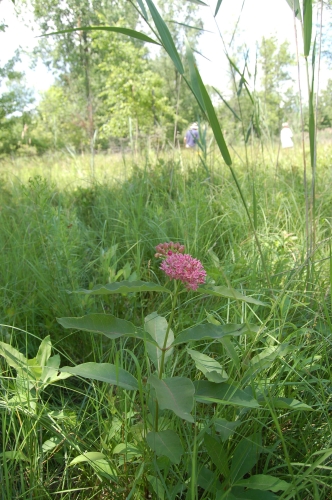Plants and Animals
Asclepias purpurascens Purple milkweed
Key Characteristics
Perennial forb of woodlands, savannas, prairies, and wetlands; leaves opposite on short petioles with dense short hairs below, tips acute; flowers purple, borne in 1-3 terminal clusters.
Status and Rank
US Status: No Status/Not Listed
State Status: T - Threatened (legally protected)
Global Rank: G4G5 - Rank is uncertain, ranging from apparently secure to secure
State Rank: S2 - Imperiled
Occurrences
| County | Number of Occurrences | Year Last Observed |
|---|---|---|
| Allegan | 1 | 2018 |
| Barry | 3 | 2022 |
| Berrien | 4 | 2022 |
| Cass | 2 | 2008 |
| Clinton | 1 | 1893 |
| Huron | 1 | 2022 |
| Ingham | 1 | 1893 |
| Jackson | 6 | 2006 |
| Kalamazoo | 5 | 2008 |
| Lenawee | 2 | 1999 |
| Livingston | 2 | 1959 |
| Monroe | 3 | 2014 |
| Muskegon | 1 | 2018 |
| Newaygo | 2 | 2009 |
| Oceana | 1 | 2006 |
| St. Clair | 3 | 2006 |
| St. Joseph | 3 | 2010 |
| Van Buren | 5 | 2022 |
| Washtenaw | 3 | 2018 |
| Wayne | 1 | 2015 |
Information is summarized from MNFI's database of rare species and community occurrences. Data may not reflect true distribution since much of the state has not been thoroughly surveyed.
Habitat
Found in a variety of habitat types, including oak and oak-pine woodlands, savanna, dry to wet prairies, thickets, prairie fens and shrub-carr.
Natural Community Types
- Bur oak plains
- Dry southern forest
- Dry-mesic northern forest
- Dry-mesic prairie
- Dry-mesic southern forest
- Lakeplain oak openings
- Lakeplain wet prairie
- Lakeplain wet-mesic prairie
- Mesic prairie
- Mesic sand prairie
- Northern hardwood swamp
- Oak barrens
- Oak openings
- Oak-pine barrens
- Prairie fen
- Rich tamarack swamp
- Southern hardwood swamp
- Southern shrub-carr
- Southern wet meadow
- Wet-mesic prairie
For each species, lists of natural communities were derived from review of the nearly 6,500 element occurrences in the MNFI database, in addition to herbarium label data for some taxa. In most cases, at least one specimen record exists for each listed natural community. For certain taxa, especially poorly collected or extirpated species of prairie and savanna habitats, natural community lists were derived from inferences from collection sites and habitat preferences in immediately adjacent states (particularly Indiana and Illinois). Natural communities are not listed for those species documented only from altered or ruderal habitats in Michigan, especially for taxa that occur in a variety of habitats outside of the state.
Natural communities are not listed in order of frequency of occurrence, but are rather derived from the full set of natural communities, organized by Ecological Group. In many cases, the general habitat descriptions should provide greater clarity and direction to the surveyor. In future versions of the Rare Species Explorer, we hope to incorporate natural community fidelity ranks for each taxon.
Associated Plants
Bluejoint grass, cordgrass, rush, sedges, twig-rush, shrubby cinquefoil, swamp milkweed, big bluestem, Indian grass, Sullivant's milkweed, purple milkweed, swamp thistle, eastern prairie fringed orchid, marsh blazing star, whorled loosestrife, grass-of-Parnassus, smooth hedge nettle, swamp rose, Missouri ironweed, prairie dropseed, three-awn grass, ironweed, tall coreopsis, and creeping cinquefoil. In oak barrens, it may also be associated with black oak, white oak, bur oak, bitternut hickory, pignut hickory, shagbark hickory, leadplant, butterfly weed, little bluestem, and big bluestem.
Management Recommendations
Maintain hydrological and natural disturbance regimes. This species most likely requires open conditions. Prevent woody plant encroachment by using prescribed fire or manual brush removal. Much of this habitat has been lost and degraded via conversion to agriculture, development, alterations of hydrology via drains, and fire suppression.
Survey Methods
Random meander search covers areas that appear likely to have rare taxa, based on habitat and the judgment of the investigator.
-
Meander search
-
Survey Period: From third week of June to fourth week of August
-
References
Survey References
- Elzinga, C.L., D.W. Salzer, and J.W. Willoughby. 1998. Measuring and Monitoring Plant Populations. The Nature Conservancy and Bureau of Land Management, Denver. BLM Technical Reference 1730-1. 477pp.
- Goff, G.F., G.A. Dawson, and J.J. Rochow. 1982. Site examination for Threatened and Endangered plant species. Environmental Management 6(4): 307-316
- Nelson, J.R. 1984. Rare Plant Field Survey Guidelines. In: J.P. Smith and R. York. Inventory of rare and endangered vascular plants of California. 3rd Ed. California Native Plant Society, Berkeley. 174pp.
- Nelson, J.R. 1986. Rare Plant Surveys: Techniques For Impact Assessment. Natural Areas Journal 5(3):18-30.
- Nelson, J.R. 1987. Rare Plant Surveys: Techniques for Impact Assessment. In: Conservation and management of rare and endangered plants. Ed. T.S. Elias. California Native Plant Society, Sacramento. 8pp.
Technical References
- Cooperrider, T.S. 1995. The Dicotyledonae of Ohio Part 2. Linaceae through Campanulaceae. Ohio State University Press, Columbus. 656pp.
- Gleason, H. A., and A. Cronquist. 1991. Manual of Vascular Plants of Northeastern United States and Adjacent Canada. Second edition. The New York Botanical Garden, Bronx. 910pp.
- Gray, A. 1950. Gray's Manual of Botany; eighth ed. Van Nostrand Reinghold, New York. 1632pp.
- Holmgren, N.H. 1998. Illustrated Companion to Gleason and Cronquist's Manual. Illustrations of the vascular plants of Northeastern United States and adjacent Canada. New York Botanical Garden, Bronx. 937pp.
- Swink, F. and G. Wilhelm. 1994. Plants of the Chicago Region, 4th ed. Indiana Academy of Science, Indianapolis. 921pp.
- Voss, E.G. 1996. Michigan Flora. Part III. Dicots (Pyrolaceae-Compositae). Bulletin of the Cranbrook Institute of Science and University of Michigan Herbarium. 622pp.


